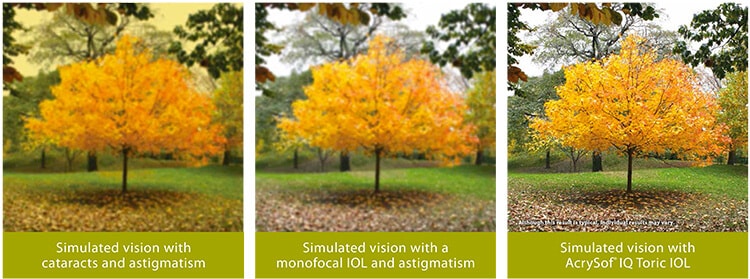During cataract surgery, the natural, cloudy lens is removed and an artificial lens is inserted inside the eye to take its place.
Clear lenses that have not yet developed cataracts are also sometimes electively replaced with an artificial lens to reduce the need for glasses or contacts.
This procedure is called a natural lens replacement or a clear lens extraction.
Every patient will have a unique set of needs and desires surrounding their vision following the surgery, and we’re happy to offer an array of options to help each individual reach their visual goal.
Some patients will choose the standard monofocal lens for their procedure. Insurance carriers will typically cover a standard monofocal lens.
MonoVision can be a great option for patients interested in reducing their dependence on glasses for both near and far distances.
Utilizing the standard monofocal lens, one eye will have a lens placed to correct distance vision, while the other eye will be corrected for near vision.
Vision is a function of the brain, and not everyone is able to adapt to this vision correction. We recommend trying contact lenses first to ensure your brain can function and adapt to this type of modification.
Astigmatism is incredibly common and occurs when the surface of the eye is shaped more like a football than a baseball. When the cornea is perfectly round like a baseball, the incoming light rays fall precisely on one spot at the back of the eye (the retina) resulting in clear vision. An eye with irregular curvature prevents the light rays from landing on one spot on the retina and instead spreads the light into multiple surrounding areas, causing distorted vision.

Presbyopia (the reason people need reading glasses) usually occurs around age 40. When we are young, the natural lens is flexible allowing vision to easily alternate between seeing objects near or far. As the natural lens hardens with age, it loses the ability to jump between near and far vision. Near vision is impacted resulting in what we call Presbyopia. Individuals who’ve never needed glasses or contacts in their life may suddenly find themselves shopping for glasses – or on the hunt for a more permanent surgical solution – cue the accommodative lens package.
Multifocal and Accommodative lenses present patients with the opportunity for less dependence on glasses following their cataract surgery.
The new Light Adjustable Lens is the first intraocular lens used for cataract patients, where you can adjust (or fine tune) the prescription after the surgery. This allows patients to ‘test drive’ their vision before locking it in.

After surgery, the lens can be adjusted for both distance and near vision. If the patient doesn’t like it, the lens can be readjusted. Glasses may be needed for specific visual tasks.
Refractive surgery such as LASIK or PRK, are often performed to decrease and eliminate corneal astigmatism in patients who are hoping for less dependence on glasses and contacts. This procedure can be performed not long after cataract surgery is complete and may be a great option for some patients.
Your cataract surgeon will discuss which astigmatism correcting option is right for you. To see if you’d be a likely candidate for one of our upgraded lenses or vision packages, you’re welcome to take advantage of our free online screening.
Minnesota Eye Consultants is proud to offer patients convenient access to eye care across the Twin Cities. We have 5 locations, each with an onsite ambulatory surgery center (ASC).